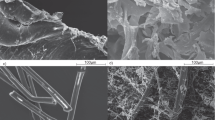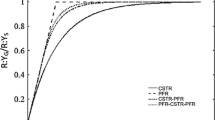Abstract
Settling and erosion experiments were carried out on a size range of fish feed pellets using an annular flume. A strong positive correlation was observed between settling rate and pellet dimension (pellet length, pellet dimeter, and equivalent sedimentation diameter). Erosion thresholds also showed a strong positive correlation with pellet dimensions. Experiments were also carried out to examine the effect of the number of pellets on erosion threshold of two sizes. The results show an asymptotic increase in erosion threshold with increasing number of pellets present, possibly due to sheltering effects. The chemical composition of the pellets was analyzed in terms of water and organic, carbon, and nitrogen contents as well as stable carbon and nitrogen isotopes. The results arising from this study will provide, information regarding potential tracers of waste feed material and help validate model predictions associated with dispersal of waste material.
Similar content being viewed by others
Literature Cited
Abbott, J. E. andJ. R. D. Frances. 1977. Saltating and suspended trajectories of solid grains in a water stream,Philosophical Transactions of the Royal Society of London 284:225–254.
Allen, J. R. L. 1985. Principles of Physical Sedimentology. Chapman and Hall, London, England.
Amos, C. L., T. F. Sutherland, D. Cloutier, andS. Patterson. 2000. Corrasion of a remoulded cohesive bed by saltating littorinid shells.Continental Shelf Research 20:1291–1315.
Ang, K. P. andR. J. Petrell. 1997. Control of feed dispensation in sea cages using underwater video monitoring: Effects on growth and food conversion.Aquaculture Engineering 16:45–62.
Beveridge, M. C. M., M. J. Phillips, andJ. D. Macintosh. 1997. Aquaculture and the environment: The supply of and demand for environmental goods and services by Asian aquaculture and the implications for sustainability.Aquaculture Research 28:797–807.
Bornhold, B. D. 1978. Carbon/nitrogen (C/N) ratios in surficial marine desiments of British Columbia. Current Research, Geological Survey of Canada, Paper 78-1C, Sidney, British Columbia.
Chen, Y.-S., M. C. M. Beveridge, andT. C. Telfer. 1999. Physical characteristics of commercial pelleted Atlantic salmon feeds and consideration of implications for modeling of waste dispersion through sedimentation.Aquaculture International 7:89–100.
Cromey, C. J., T. D. Nickell, K. D. Black, P. G. Provost, andC. R. Griffiths. 2002b. Validation of a fish farm waste resuspension model by use of a particulate tracer discharged from a point source in a coastal environment.Estuaries 25:916–929.
Cromey, C. J., T. D. Thomas, andK. D. Black. 2002a. DEPOMOD—Modeling the deposition and biological effects of waste solids from marine cage farms.Aquaculture 214:211–239.
Doughty, C. R. andC. D. McPhail. 1995. Monitoring the environmental impacts and consent compliance of freshwater fish farms.Aquaculture Research 26:557–565.
Dudley, R. W., V. G. Panchang, andC. R. Newell. 2000. Application of a comprehensive modeling strategy for the management of net-pen aquaculture waste transport.Aquaculture 187:319–349.
Findlay, R. H. and L. Watling. 1994. Toward a process level model to predict the effects of salmon net-pen aquaculture on the benthos, p. 47–77.In B. T. Hargrave (ed.), Modelling Benthic Impacts of Organic Enrichment from Marine Aquaculture. Canadian Technical Report of Fisheries and Aquatic Sciences, No. 194. Dartmouth, Nova Scotia.
Fung, A. 1997. Calibration of flow field in mini flume. Geological Survey of Canada, Atlantic Dartmouth, Nova Scotia, Canada.
Gowen, R. J., D. Smith, and W. Silvert. 1994. Modelling benthic impacts of organic enrichment from marine aquaculture, p. 19–30.In B. T. Hargrave (ed.), Modelling Benthic Impacts of Organic Enrichment from Marine Aquaculture. Canadian Technical Report of Fisheries and Aquatic Sciences, No. 1949. Dartmouth, Nova Scotia.
Gowen, R. J. andN. B. Bradbury. 1987. The ecological impact of salmonid farming in coastal waters: A review.Oceanography and Marine Biology Annual Review 25:563–575.
Hansen, P. K., K. Pittman, andA. Ervik. 1991. Organic waste from marine fish farms—Effects on the seabed.Marine Aquaculture Environment 1:105–119.
Hargrave, B. T., D. E. Duplisea, E. Pfeiffer, andD. J. Wildish. 1993. Seasonal changes in benthic fluxes of dissolved oxygen and ammonium associated with marine culture Atlantic salmon.Marine Ecology Progress Series 96:249–257.
Henderson, A. R. andD. J. Ross. 1995. Use of macrobenthic infaunal communities in the monitoring and control of the impact of marine cage fish farming.Aquaculture Research 26:659–678.
Juell, J. E., D. M. Furevik, andA. Bjordal. 1993. Demand feeding in salmon farming by hydroacoustic food detection.Aquaculture Engineering 12:155–167.
Kelly, L. A. 1993. Release rates and biological availability of phosphorus released from sediments receiving aquaculture wastes.Hydrobiologia 253:366–372.
Kelly, L. A. 1995. Predicting the effect of cages on nutrient status of Scottish freshwater lochs using mass-balance models.Aquaculture Research 26:469–477.
Lavelle, J. W. andH. O. Mofjeld. 1987. Do critical stresses for incipient motion and erosion really exist?Journal of Hydraulic Engineering 113:370–393.
Merican, Z. O. andM. J. Phillips. 1985. Solid waste production from rainbow trout,Salmo gairdneri Richardson, cage culture.Aquaculture Fisheries Management 1:55–69.
Panchang, V., G. Cheng, andC. Newell. 1997. Modeling hydrodynamics and aquaculture waste transport in coastal Maine.Estuaries 20:14–41.
Petersen, S. A., T. F. Sutherland, andD. Higgs. 2005. Physical and chemical characterization of salmonid feed pellets.Canadian Data Report of Fisheries and Aquatic Sciences 1159:1–12.
Ridley, C. 2004. An evaluation of the balance of forces acting on bodies of varying size, shape, and density. Honours Thesis, University of Southampton, Southampton, U.K.
Sara, G., D. Scilipoti, A. Mazzola, andA. Modica. 2004. Effects of fish farming waste to sedimentary and particulate organic matter in a southern Mediterranean area (Gulf of Castellamare, Sicily): A multiple stable isotope study (δ13C and δ15N).Aquaculture 234:199–213.
Seymour, E. A. andA. Bergheim. 1991. Towards a reduction of pollution from intensive aquaculture with reference to the farming of salmonids in Norway.Aquaculture Engineering 10:73–88.
Sternberg, R. W. 1972. Predicting initial motion and bedload transport of sediment particles in the shallow marine environment, p. 61–97.In D. J. P. Swift, D. B. Duane, and O. H. Pilkey (eds.), Shelf Sediment Transport: Process and Pattern. Dowden, Hutchinson and Ross, Stroudsberg, Pennsylvania.
Stucchi, D., T. Sutherland, C. Levings, andD. Higgs. 2005. Near-field depositional model for salmon aquaculture waste, p. 157–179.In B. Hargrave (ed.), The Handbook of Environmental Chemistry: Environmental Effects of Marine Finfish Aquaculture, Volume 5., Springer Verlag, Berlin.
Sutherland, T. F., C. L. Amos, andJ. Grant. 1998. The erosion threshold of sediments: A comparison of methods, p. 295–307.In K. S. Black, D. M. Peterson, and A. Cramp (eds.), Sedimentary Processes in the Intertidal Zone, Volume 139. Geological Society, London, U.K.
Sutherland, T. F., A. J. Martin, andC. D. Levings. 2001. Characterization of suspended particulate matter surrounding a salmonid net-pen in the Broughton Archipelago, British Columbia.ICES Journal of Marine Science 58:404–410.
Swamee, P. andS. Ojha. 1991. Drag coefficient and fall velocity of nonspherical particles.Journal of Hydraulic Engineering 117:660–667.
Thompson, C. E. L. andC. L. Amos. 2002. The impact of mobile disarticulated shells ofCerastoderma edulis on the abrasion of a cohesive substrate.Estuaries 25:204–214.
Thorpe, J. E., C. Talbot, M. S. Miles, C. Rawlings, andD. S. Keay. 1990. Food consumption in 24 hours by Atlantic salmon (Salmo salar L.) in a sea cage.Aquaculture 90:41–47.
Troell, M. andH. Berg. 1997. Cage fish farming in the tropical Lake Kariba, Zimbabwe: Impact and biogeochemical changes in sediment.Aquaculture Research 28:527–544.
Trojanowski, J., C. Trojanowska, andH. Ratajczyk. 1982. Effect of intensive trout culture in Lake Letowo on its bottom sediments.Polski Archiwum Hydrobiologii 29:659–670.
Van Rijn, L. C. 1990. Principles of Sediment Transport in Rivers, Estuaries and Coastal Seas. Aqua Publications, Amsterdam, The Netherlands.
Wildish, D. J., B. T. Hargrave, andG. Pohle. 2001. Cost-effective monitoring of organic enrichment resulting from salmon mariculture.ICES Journal of Marine Science 58:469–476.
Ye, L.-X., D. A. Ritz, G. E. Fenton, andM. E. Lewis. 1991. Tracing the influence on sediments of organic waste from a salmonid farm using stable isotope analysis.Journal of Experimental Marine Biology and Ecology 145:161–174.
Yeats, P. A., T. G. Milligan, T. F. Sutherland, S. M. C. Robinson, J. A. Smith, P. Lawton, andC. D. Levings. 2005. Lithiumnormalized zinc and copper concentrations in sediments as measures of trace metal enrichment due to salmon aquaculture, p. 207–220.In B. T. Hargrave (ed.), The Handbook of Environmental Chemistry: Environmental Effects of Marine Finfish Aquaculture, Volume 5. Springer Verlag, Berlin.
Author information
Authors and Affiliations
Corresponding author
Rights and permissions
About this article
Cite this article
Sutherland, T.F., Amos, C.L., Ridley, C. et al. The settling behavior and benthic transport of fish feed pellets under steady flows. Estuaries and Coasts: J ERF 29, 810–819 (2006). https://doi.org/10.1007/BF02786532
Received:
Revised:
Accepted:
Issue Date:
DOI: https://doi.org/10.1007/BF02786532




